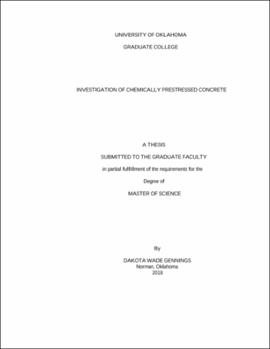| dc.description.abstract | This research investigated the possibility of prestressing a concrete element by inducing expansion of the concrete paste at an early age. This behavior is being called chemically prestressed concrete, for this project, was studied by varying the amount of expansion. A literature review was performed which outlines different experiments investigating the chemical prestressing of concrete. Two of the main focuses of the literature review are the chemical structure of calcium sulfo-aluminate cements and chemically induced axial force.
Phase one of this research was to investigate the varying levels of expansion by using 21%, 23%, 25%, 27%, and 29% replacement by weight of portland cement with an expansive mineral admixture. The mix designs developed in phase one of this research utilized the varying percentages of expansive mineral admixture. The concrete’s expansion or shrinkage was measured over an extended period using restrained prisms and restrained cylinders. The specimens were wet cured for the first seven days, allowing expansion to develop. The prisms were measured using a length comparator. The restrained cylinders were measured using a vibrating wire strain gage (VWSG) system. The VWSG were connected to a Geokon data acquisition system to constantly read the expansion or shrinkage at an interval of 15 minutes.
Phase two of this research investigated the use of internal restraint to develop the prestress of the concrete. The internal restraint conditions included four types of steel fibers: CTS proprietary, Novocon 1050 he, Novocon XR, and Dramix. The mix design with 25% replacement of Portland cement with the expansive mineral admixture was used throughout phase two. The same type of restrained prisms and restrained cylinders were monitored to determine the amount of restraint provided by each fiber type.
Phase three of this researched included casting a series of slabs to examine the behavior on a larger scale. Three slabs were cast using the 25% replacement of Portland cement with the expansive mineral admixture to monitor the amount of restraint provided by the differing reinforcements. Slab 1 had no reinforcement of steel fibers in the 25% replacement of Portland cement with the expansive mineral admixture, slab 2 had a No. 5 bar around the edges of the slab, and slab 3 had the Novocon XR steel fibers. All three slabs were instrumented with three VWSG’s throughout. The VWSG’s were placed longitudinally along the tip and midpoint and transversely in the midpoint of the slab.
The tests conducted show how significantly a change in the percentage of expansive mineral admixture can affect the expansion of the concrete. The results show a trend in which increasing expansive mineral admixture created increased expansion. The steel fibers created internal restraint of the expansion, but each fiber type created a different level of restraint. The fibers internal restraint can create a material induced prestress by restricting the expansion and carrying the associated stress from restraining the expansion. Chemically prestressed slabs have the potential for becoming used in industry, but the sizing effect must be accounted for when designing. | en_US |
